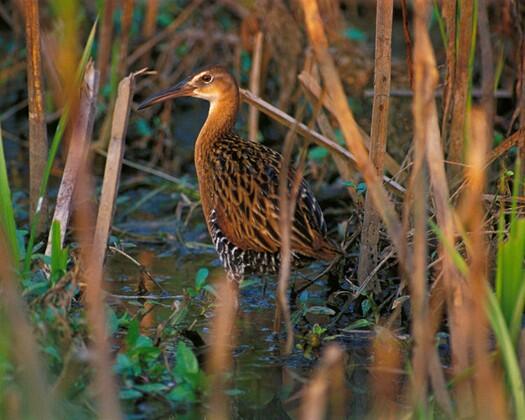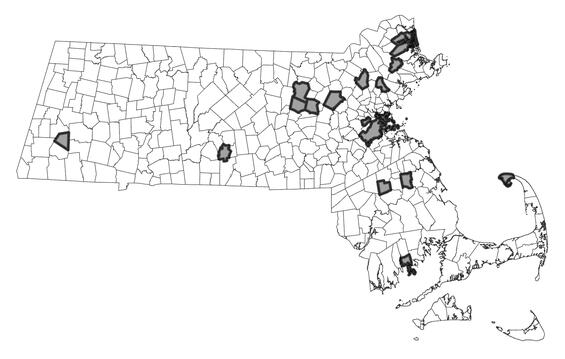- Scientific name: Rallus elegans
- Species of Greatest Conservation Need (MA State Wildlife Action Plan)
- Threatened (MA Endangered Species Act)
Description

King rail (Rallus elegans)
The king rail is the largest of the New England rails, measuring 38-48 cm (15-19 in) with a wingspan of 53-64 cm (21-25 in). The king rail has a plump body, similar to that of a chicken. Its long slender bill curves downward and varies in color from orange-red to dark brown. Upper parts of the king rail are olive-brown, streaked with a brownish-black or olive-gray. The wings are brown and its upper throat is whitish. Over each eye a brownish-white or brownish-orange line turns to brownish-gray behind the eye. The entire chest and sides of the neck are a deep reddish-brown. Male and female are similar in plumage; the male is slightly larger than the female. The call of the king rail is described as a jupe-jupe-jupe-jupe-jupe with the tempo increasing and the volume decreasing as it calls.
King and clapper rails have been found together in salt and brackish-water marshes. They have similar plumage and have been known to hybridize where their ranges overlap. The clapper rail is smaller and grayer in color than the king rail. The clapper rail also has paler flank barring. The call of the clapper may also be more rapid than that of the king rail.
Life cycle and behavior
Nesting in Massachusetts takes place primarily in June. Nests are typically placed on a sedge tussock just above the surface of the water. Nests are woven with cattails, sedges or other vegetation found in the marsh. Typically, in the north, one clutch is laid yearly with 10-12 eggs that are a glossy pale buff varying from cream-buff to pale olive-buff. Incubation of the eggs normally is from 21-23 days. The young are precocial and are able to walk around one hour after hatching. The diet of the king rail consists mainly of crustaceans and aquatic insects.
Population status
The population seems somewhat stable in the southern United States, but its northern range is seeing a decrease in population that can partially be attributed to wetland habitat loss. The king rail has most likely always been a local and rare breeder in Massachusetts and is listed as a Threatened species in Massachusetts.
Distribution and abundance
Massachusetts is at the northern edge of the king rail’s range. The king rail has most likely always been a rare and local breeder in the state. Overall, the king rail breeds from the Gulf Coast to southern Ontario and from the Atlantic Coast to the Great Plains. It winters from the Delaware Valley to the southeastern portions of Florida and westward to the Gulf Coast and to Texas. Local occurrences in the state have occurred in Berkshire, Plymouth, Essex and Worcester counties.

Distribution in Massachusetts. 1999-2024. Based on records in the Natural Heritage Database.
Habitat
King rails nest in shallow water areas with emergent vegetation (cattails, grasses, and sedges), usually in large cattail marshes or extensive wet meadows.
Healthy habitats are vital for supporting native wildlife and plants. Explore habitats and learn about conservation and restoration in Massachusetts.
Threats
Invasion of wetlands by Phragmites is the primary modern threat to breeding king rails is in Massachusetts. Wakes from boats and jet skis may swamp nests.
Conservation
Protection of important marsh habitat and maintaining this habitat free of invasive species (particularly Phragmites) is a key component of marshbird conservation. Maintaining a consistent water hydrology during the nesting season is important for the king rail and other wetland nesting birds.
References
Fredrickson, L.H., B. Meanley, and F.A. Reid. “King Rail.” 1994. Pages 181-191 in T.C. Tacha and C.E. Braun, eds. Migratory Shore and Upland Game Bird Management in North America. International Association of Fish and Wildlife Agencies, Washington, D.C.
Meanley, B. “King Rail.” 1992. The Birds of North America, No. 3 (A. Poole, P. Stettenheim, and F. Gill, Eds.). Philadelphia: The Academy of Natural Sciences; Washington, D.C.: The American Ornithologists’ Union.
Meanley, B. Natural History of the king rail. 1969. North American Fauna, No. 67. U.S. Department of the Interior, Bureau of Sport Fish and Wildlife.
Contact
| Date published: | April 4, 2025 |
|---|